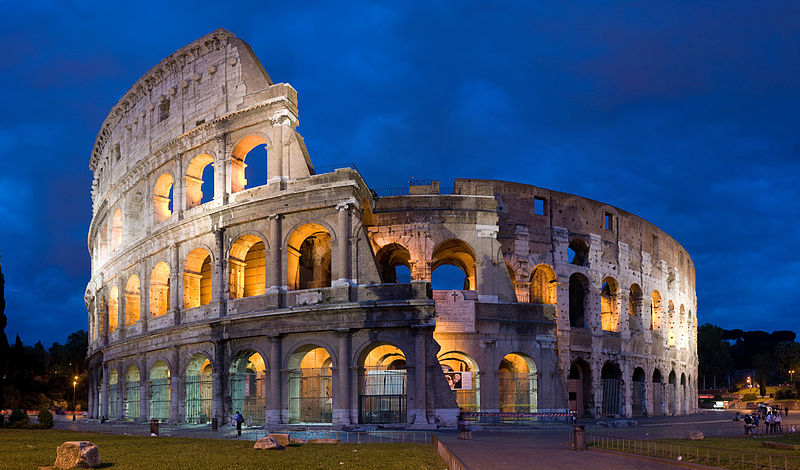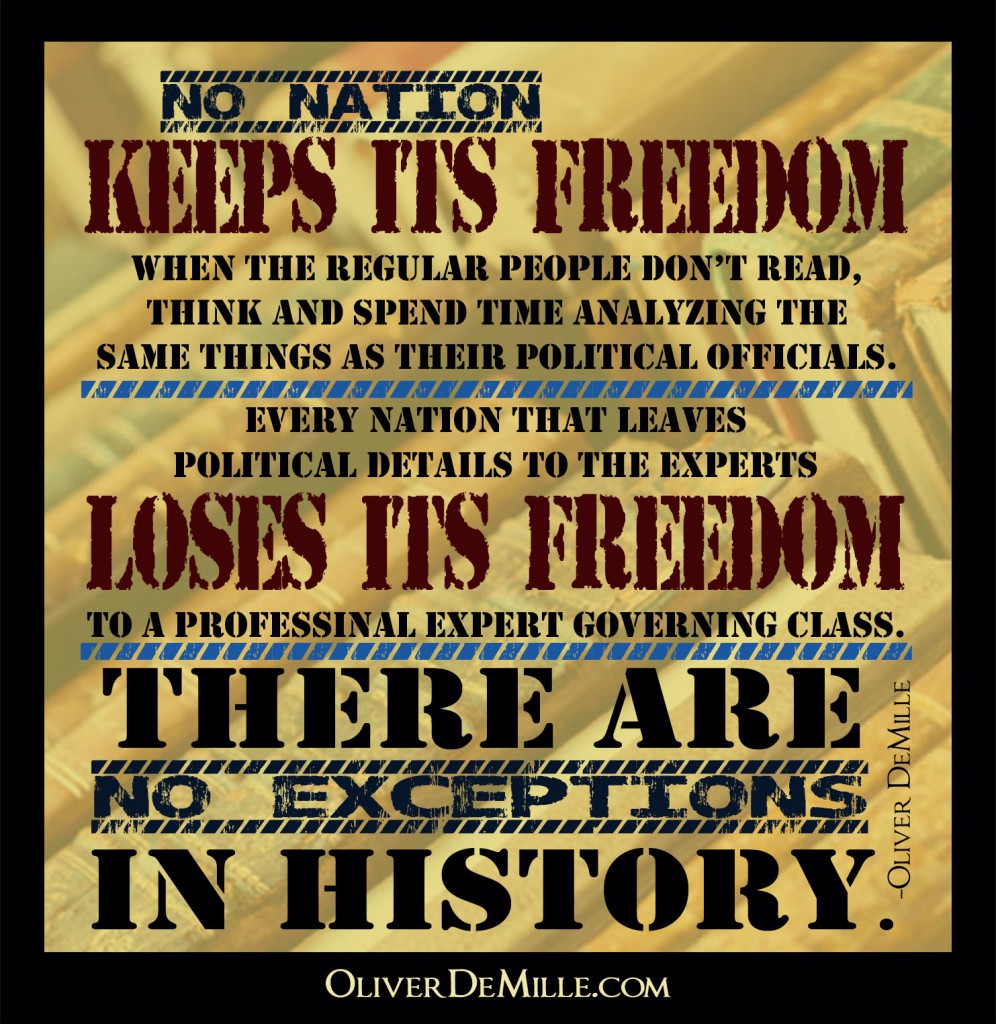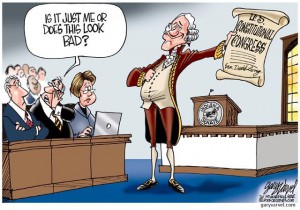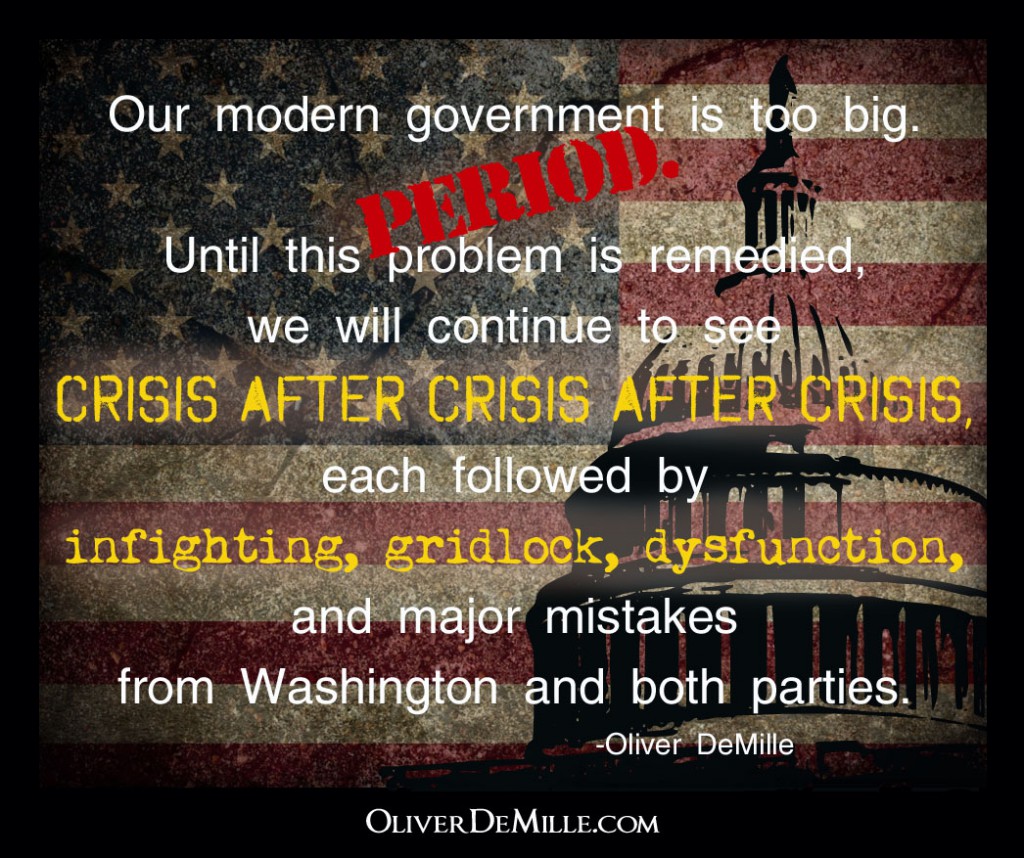How to Realistically End Obamacare and Stop the Iran Deal
September 22nd, 2015 // 11:21 am @ Oliver DeMille
by Oliver DeMille
Emotions and Questions
 A lot of Americans are deeply frustrated. Many of them are downright angry about the direction our nation is taking. We use our power as citizens to change things—through elections. We send Congressmen and Senators to reverse things we don’t like, but they don’t do much. Why? “Because they can’t,” people tell me. “Because the president will just veto whatever they do. Or the Court will just decree whatever it wants. We’ve got no power. Our votes don’t accomplish anything.”
A lot of Americans are deeply frustrated. Many of them are downright angry about the direction our nation is taking. We use our power as citizens to change things—through elections. We send Congressmen and Senators to reverse things we don’t like, but they don’t do much. Why? “Because they can’t,” people tell me. “Because the president will just veto whatever they do. Or the Court will just decree whatever it wants. We’ve got no power. Our votes don’t accomplish anything.”
The Founder’s Way
The American founding fathers knew that situations like this would come up, so they wrote the Constitution in a very specific way. They gave the power of the purse strings to the House of Representatives for two vital reasons:
First, because they knew that the power to fund or defund any government action was the ultimate power in the Constitution. This power affects everything the government does. No budget equals no personnel, no staff, no petty cash, no anything. This is real teeth. And the framers gave it to the House so they would use it!
Second, the framers gave this power only to the House of Representatives. Why? Because Congressmen are elected directly by the voters, and they are elected every two years. Thus if Washington gets off track, the voters can re-constitute the entire House of Representatives every 24 months. The whole thing. And this new House can totally rewrite the budget. All of it .The House can refuse to fund anything, and that thing will go away.
The framers wanted the House to use the purse powers to defund or refuse to renew funding on things the people don’t like—such as Bush’s torture policies or secret big data spying on American citizens, or today’s Obamacare, federal funding of Planned Parenthood, the Iran deal, and other proposals at this level. That’s why the framers set up the Constitution the way they did.
Presidential vetoes, Court decisions, Senatorial refusals to confirm a presidential nomination, and House refusal to funding: these are all routine constitutional tools. And let’s be clear. The power of the purse is the exact level of extreme that the framers made it. The Court can say something’s constitutional and even say this part of government should stay open. The House can decide whether to fund that thing with $3 trillion or with 30 cents.
The framers knew that the president would have the power of the military, the Court would have the power of legal decisions, the Senate the power of treaties—and they wanted the House to have an equal power. This is the people’s power. This is the House’s power. It is pretty much their only real power. If they don’t use it, they have very little power. But if they do use it, they have the most power in Washington.
Indeed, the power of the purse, the House’s ability to simply withhold funding to the government on any new funding proposal, or renewed funding plan, is the “people’s veto” on the president and the Court. Yet today the president uses his veto power all the time, and the Court uses its decision-making power all the time, while the House almost never uses their veto power.
Why? Because when they do, the media convinces the American electorate that “shutting down the government” is somehow not part of the Constitution.
But the truth is the exact opposite. This House veto is absolutely vital.
Check and Balance
“But that’s so drastic,” some people say. “Shutting the government down is out of bounds. It’s extreme!”
Actually, it’s no more drastic or extreme than a presidential veto. Both of these powers were put in the Constitution by the framers for the same reason—the veto power to allow the president to check Congress, and the power over the purse to allow Congress to check the president.
It’s the most basic part of our governmental system. The three branches can check and balance each other. The president by veto, the Court by decision, the Senate by withholding confirmations, and the House by the power of the purse—by withholding funding. The framers did this on purpose. This is the whole point of three separate branches of government operating with checks and balances.
But the only Constitutional teeth the House has against the president is the power of the purse. And if the House never uses its Constitutional teeth against the president, then we’re living under a monarchy, not a democratic republic. The president will just do whatever he decides to do. That’s not freedom.
Our problems in Washington aren’t caused by vetoes and the checks and balances. Our problems are nearly all the result of not following the Constitution with its checks and balances. Just refuse to fund the agenda of any president who tries to use too much power (like sign a treaty with Iran by executive order instead of following the Treaty requirements in the Constitution). For the current Congress: Don’t renew funding of Obama programs until he takes you seriously. Until he stays within the Constitution. Stop funding his agenda, and he’ll stop doing whatever he wants. He’ll be forced to stop the overreach.
Stop blaming the White House, and stop blaming the Court. It’s 100% in the power of the House or the Senate. And the American citizenry needs to know this. If we don’t even know how powerful our votes make us under our Constitution, we’ll just keep getting more and more bad government.
Note: Americans need to know this. Please pass it on…
Category : Aristocracy &Blog &Citizenship &Community &Constitution &Culture &Current Events &Foreign Affairs &Generations &Government &History &Independents &Leadership &Liberty &Politics
Ron Paul Is the Winner in 2015 by Oliver DeMille
September 18th, 2015 // 7:14 am @ Oliver DeMille
Why the Republican Establishment Is Surprised
(and a bit clueless)
by Oliver DeMille
Shock and Awe
 The current presidential election has left most of the Establishment speechless. They are shocked by the rise of Bernie Sanders, shocked by the success of Donald Trump in the polls, and shocked by the popularity of Ben Carson. “Shocked” may actually be too weak a word. Apoplectic, maybe?
The current presidential election has left most of the Establishment speechless. They are shocked by the rise of Bernie Sanders, shocked by the success of Donald Trump in the polls, and shocked by the popularity of Ben Carson. “Shocked” may actually be too weak a word. Apoplectic, maybe?
The Establishment is also surprised by the struggles of Hillary Clinton, Jeb Bush, Marco Rubio, and Scott Walker—all of whom were widely predicted to dominate this election cycle.
“Why is this happening?” is a popular question on many political news programs right now. Along with: “Will it continue?” “What will happen next?” and “Why are the voters so angry?”
Conservatism 1.0
The answer is fascinating. To get there, let’s start with the roots of the modern conservative movement. Initiated largely by William F. Buckley, Jr. and his colleagues in the 1950s and 1960s,[i] Conservatism 1.0 struggled, persisted, gained support slowly, and then rose to victory with the election and presidency of Ronald Reagan.
The Party of Reagan was based firmly on the view that “liberalism is bad.” In this environment, Reagan’s GOP found itself directly opposed to the Democratic Party of Franklin Delano Roosevelt and his progressive successors.
The ensuing debate pitted conservatism against liberalism in a few direct, simple ways: limited government versus big government, Constitutional originalism versus judicial activism, American exceptionalism versus European style internationalism, and individualism versus collectivism.
Republicans saw conservatism as good precisely because it espoused limited government, strict adherence to the Constitution, American leadership in the world, and individual freedoms. They saw liberalism as bad because it promoted big government, an activist Court, American subordination to international organizations, and widespread collectivism through higher taxes and increased government programs in all facets of life.
This was the battle of Postwar America. And conservatives saw themselves as the Keepers of Freedom and Family Values in this monumental conflict—warriors for the American Dream and the American way of life.
After the financial downgrade of the Soviet Union during the Reagan years and the fall of the Berlin Wall in 1989, the battle lines were slowly redrawn. New superpowers emerged on the world stage, and existing alliances began to unravel. Naturally, during the 1990s the old battles were replaced with new ones, and in the 2000s world and national allegiances were weakened, redirected, and reconceived.
But the hearts of many 20th Century conservatives (and liberals, for that matter), raised and steeped in the old battles, didn’t change.
Conservatism 2.0
 A new cultural movement sprouted in the different soil after 1989. In technology, this shift was exemplified by Steve Jobs, and eventually Elon Musk. In business, the iconic figureheads were Bill Gates and Warren Buffett. And on the political front, the pioneers of a new model were Ross Perot and Ralph Nader, and later Bernie Sanders and Ron Paul.
A new cultural movement sprouted in the different soil after 1989. In technology, this shift was exemplified by Steve Jobs, and eventually Elon Musk. In business, the iconic figureheads were Bill Gates and Warren Buffett. And on the political front, the pioneers of a new model were Ross Perot and Ralph Nader, and later Bernie Sanders and Ron Paul.
Congressman Paul’s contribution to the new brand of conservatism that arose is hard to overstate. For example:
- It replaced Reagan’s 11th Commandment (“Thou shalt not criticize other Republicans”) with a focus on principles of freedom rather than institutional political parties.
- It walked a fine (and frequently uneasy) line between party loyalty and going independent, finally resting on the idea that independence is more important than party—but sometimes it’s possible to get both.
- It called into question widespread U.S. military interventionism.
- It reemphasized the Constitution as a central, literal theme, rather than a mere national symbol.
- It put actual free enterprise above the rhetoric of free enterprise (rhetoric that most Republican presidents had ironically combined with bigger government).
- It appealed strongly to populism—“this is the people’s government, not vice versa.”
- It switched the viewpoint of conservatism from “liberalism is bad” to “government by elite power brokers and their bureaucratic agents is bad.”
Paul himself wasn’t able to convert this revolution into a White House victory, but the revolution occurred nonetheless. And the 7th point of this revolution is perhaps the most important. It animated the Tea Parties, the elections of 2010 and 2014, and it is still growing today.
It also explains the shock of the current Republican Establishment with the ousting of Eric Cantor, the support for Donald Trump, Ben Carson, and Carly Fiorina, and the popularity of Ted Cruz in comparison to Jeb Bush or Scott Walker.
Mitch McConnell, John Boehner, John McCain, Mitt Romney, Jeb Bush, and most of the Republican Establishment are operating as if the GOP is still Reagan’s party. But this is debatable. A large segment of the party is now more aligned with Conservatism 2.0.
Thus the passionate battle now underway for the future of the GOP. And with each passing election cycle, the popularity of Conservatism 2.0 is increasing.
What 2.0 Conservatives Want
To these new conservatives, the idea that “liberals are bad” is SO forty years ago. The real issue now is that “government by elites” is bad.[ii] “The elite class is bad. It is corrupt, and it’s hurting us all. It is hurting America.” In fact: “Corruption is bad. And elites are corrupt.” This viewpoint is growing.
And to members of the new conservatism, Republican elites are just as bad as liberal elites. Many consider them even worse, like modern wolves in sheep’s clothing, claiming conservatism, and gaining support for their candidates and policies by invoking conservatism, while refusing to passionately or effectively fight for it.
It is important to clarify that the Ron Paul revolution didn’t win all 7 of its main themes. The new 2.0 conservatives never warmed up to items 3 and 4, for instance:
3-less U.S. military interventionism in the world
4-more emphasis on the literal words of the Constitution
But, on the other hand, they bought the following principles hook, line and sinker:
1-focus on principles of freedom rather than institutional parties
6-populism: forget “electability” and support the candidate we think will really bring about the changes we want
7-government by elites is corrupt and bad
This tectonic shift put Carson, Trump, Fiorina and Cruz at center stage.
A Question
It remains to be seen if a 2.0 candidate can become the nominee anytime soon. And even more significant is the question of whether a 2.0 president will actually apply item 5 from the list:
5-actual free enterprise is the goal, not just the rhetoric of free enterprise
Such an approach would lead to balanced budgets, reversal of the U.S. national debt, and a high-growth economy spurred by a massive rollback of anti-small business regulation. Right now many 2.0 voters are split. They’re asking themselves if Trump or Fiorina would actually lead a serious downsizing of government—or instead just expand government like past 1.0 conservative presidents.
As for Carson and Cruz, they seem clearly committed to this approach, but 2.0 conservatives wonder if they have the capacity or authentic will to actually pull it off.
If the 2.0 crowd ever coalesces around one candidate, he or she is going to be very hard to beat—in the primaries, and even in the general. A motivated 2.0 nation will be very persuasive among independents, women, and young voters. And 2.0 is very strong in the swing states. But 2.0 conservatives won’t “go for it” if they are at all uneasy about the candidate’s direction or ability. They are, in a sense, playing the long game, and won’t blow their one-shot-at-the-big-house political capital on an also-ran.
The Election
A long primary and general election fight is still ahead, and this war between conservatism 1.0 and 2.0 won’t be easily resolved. It has already turned nasty, and it will probably get a lot worse.
But if 1.0 wins, if Jeb or another Establishment candidate is the eventual nominee, this fight will rage on. Conservatism 2.0 is young, passionate, and has the benefit of a large and growing base. It may or may not get its way in 2016, but all indications are that it will eventually win the war.
When it does, expect the president it propels into the White House to alter American history as significantly and lastingly as the 1.0 movement did with Ronald Reagan.
(Read more discussion on these themes in FreedomShift, by Oliver DeMille)
[i] With significant support by additional voices including Leo Strauss, Milton Friedman, Leonard Read, Friedrich Hayek, Russell Kirk, Richard Weaver, Ludwig von Mises, Ayn Rand, and Margaret Thatcher, among others.
[ii] In comparison, Liberalism 2.0, supported early on by Hobson and Mencken and Keynes, among others, and perhaps most embodied in current events by President Obama (and espoused by Bernie Sanders), frequently operates on the idea that “America is bad.” European social democracy is promoted as the alternative, the ideal, and the goal.
Category : Aristocracy &Blog &Citizenship &Community &Constitution &Culture &Current Events &Economics &Foreign Affairs &Generations &Government &History &Independents &Leadership &Liberty &Mission &Politics &Statesmanship
The Real Crisis of the 2016 Election by Oliver DeMille
September 10th, 2015 // 6:30 am @ Oliver DeMille
“U.S. median income is $42,000 per year, while the European median income is $27,000. That’s close to the average difference in annual income between U.S. high school grads ($28,000) and college graduates ($45,000). And the current elite class wants America to become more like Europe. This explains much of what Washington is doing these days.”
What Is Coming
 There is a serious crisis coming. Most people just hope it won’t come. Their subconscious minds tell them: “If we hope hard enough, and avoid thinking about it, maybe it won’t happen.”
There is a serious crisis coming. Most people just hope it won’t come. Their subconscious minds tell them: “If we hope hard enough, and avoid thinking about it, maybe it won’t happen.”
Sadly, it isn’t quite that simple. The crisis is coming.
What’s the Crisis? Imagine this: It’s the summer of 2017, and we have another career politician in the White House. On the day of the 2016 election, or even earlier, we learned that none of the anti-Establishment candidates were going to win. Instead, the media informed us that the American electorate was putting another regular politician into office.
And since inauguration day, that president has followed a path similar to earlier presidents, from Bush I and Clinton, to Bush II and Obama: the national debt is still skyrocketing, our foreign policy is a disaster, the government is growing, increased regulations attack our prosperity every month, and the Supreme Court is legislating additional policies that hurt the nation.
On top of all this, the mandates of Obamacare are really kicking in now, increasing many small business costs by 30% or more annually—and as a result, those businesses that survive are laying off large numbers of employees. Your family health insurance premiums are up many thousands of dollars a year. The economy is still struggling, with less than a 2% growth rate, and good-paying jobs are increasingly scarce. At least one or two of your close friends or family members have lost their jobs.
In other words, it’s clear that the 2016 election has changed almost nothing. Terrorist attacks are increasing in both Europe and a few targeted attacks in the United States—as Iran uses its new $100 billion dollars to fund such violence. ISIS is still spreading, and China continues to increase its naval presence around the Pacific Rim. Moreover, Putin is becoming increasingly aggressive, not just in Eastern Europe but also in Syria, the North Pole, and the Pacific.
If the new president is a Democrat, there is a strong push to increase taxes and federalize even more state-level programs. If, contrast, if the president is a Republican… well, exactly the same thing is happening.
If we vote for the same kind of candidate we’ve voted for since 1988 (a career politician), we’re going to get the same thing we’ve experienced since…you know…1988. Meaning that career politicians are going to give us the same thing that career politicians have always given us:
Increased government. Very little positive change. A continual slide toward bigger government, higher debts, and decreased individual prosperity and freedoms.
Coming Paths
This is the crisis ahead: More of the same. Except that it’s continually a bit worse, year after year, election cycle after election cycle.
“The definition of insanity,” you remind yourself, “is to keep doing the same thing while expecting different results.” In business, the prime directive is that to actually change an organization, you have to significantly change the leadership. If career politicians keep running the White House, little is going to change. This is true.
It’s frustrating. We don’t want to believe it, because we hope things will be different this time. But each election proves that it’s the reality. Career politicians do what career politicians do. Over and over.
Specifically: whatever career politicians say as candidates, once they’re elected they do what they’ve done before. Count on it. The following presidential candidates are not going to bring much change to Washington:
- Joe Biden
- Hillary Clinton
- Jeb Bush
- Chris Christie (to his credit, Christie is openly promising to do what career politicians do: just more of the status quo)
- Marco Rubio
- Scott Walker
- John Kasich (actually, at least Kasich has balanced two major budgets—the federal budget during the 1990s, and Ohio’s budget while serving as governor; thus, he’ll likely do this again—even if he doesn’t do much else, this is a pretty good thing)
But does anyone actually believe that if Jeb Bush is elected president we’ll reverse the national debt, repeal Obamacare, or seriously send education decisions and funding back to the states, where it belongs? No way.
The above candidates are part of the system; and reaching the pinnacle of the system they’ve spent their lives supporting won’t incentivize them to drastically change things. Whatever your political views, it’s clear that those who’ve made their lives in the system aren’t likely to alter it in any significant way. Period.
The following are a lot more likely to really change things:
- Bernie Sanders
- Carly Fiorina
- Rand Paul
- Donald Trump
- Ted Cruz
- Ben Carson
Say what you want about them, but they aren’t part of the typical Washington Establishment.
If elected, would one of them actually change things?
Maybe. Maybe not. But there is at least a chance.
In contrast, with the first list above, there’s no reasonable, rational expectation of real change.
Part II: What Will the Crisis Look and Feel Like for Americans?
Beyond the question of whether or not real change will come after the 2016 election, a deeper question is this: “If it doesn’t come, what will happen?”
In other words, “Where is our current national trajectory taking us?” First of all, if real change does come, it could take a number of different directions. That’s what change does. Genuine change is almost impossible to predict, because a significant change causes so many additional, cascading, changes.
If anyone on the first list above becomes our next president, I believe we have less than a 1% chance of changing course in a serious way that really shifts our national direction. Even if someone on the second list is elected, I’m convinced we’ll have less than a 40% chance of such a course correction (and 0% if it’s Bernie Sanders).
And let’s be clear: a course correction is desperately needed. If it doesn’t come, where are we headed?
Answer: In the early 1960s, many in the Euro-American elite class adopted the idea that the U.S. was beginning to outpace the nations of Western Europe—economically, technologically, and militarily. Moreover, they calculated that such a divide would be bad for business (specifically the business of the elites, which includes both the economic endeavors of the 1% and also their political influence).
To combat this growing divide, the elites began using their institutional, fiscal, and monetary influence to make the United States more like Europe. They began in earnest by dropping the gold standard in 1971, and providing an influx of elite money into higher education donations and endowments, and simultaneously with increased investment in and ownership of major media outlets.
Influenced by these funds and those who provided them, education began spreading the idea that America should be more like Europe, and the graduates of these programs increasingly dominated the campus scene through the seventies and eighties. By 1987, Allan Bloom decried what amounted to the Europeanized politicization of higher education in his bestselling book The Closing of the American Mind.
Choosing a Dream
Media increasingly reinforced this same message—“America should be more like Europe”—in stories and reports, from the major national newspapers to the Big 3 television networks. Nearly all cable channels and Establishment-supported Internet news outlets followed suit.
Among Establishment policy makers, Samuel Huntington’s writings on “Civilizations” and Francis Fukayama’s “End of History” essays pointed U.S. financial-, domestic-, and foreign-policy institutions (and bureaucracies) in the same direction.
Where does this leave us today? The “American Dream” includes the ideal that each household should achieve home ownership, financial independence (at least by the time of retirement), cars, savings, education for the kids, and a better lifestyle for each additional generation. In contrast, a middle class family in Europe typically lives in an apartment, has fewer children than American families, owns (on average) less than one car, and expects decreasing financial opportunities for coming generations.
To put this in financial terms, the U.S. median income is $42,000 per year, while the Western European median annual income is $27,000.
While it may not appear so at first, these numbers are drastically different—especially if you are applying for a home or vehicle loan, trying to start a business, deciding how many children to have, or funding a child’s college education. Indeed, an American family of three making the European median income of $27,000 a year typically lives in an apartment and has approximately $4,050 a year or less in disposable income. The U.S. median income of $42,000 upgrades the family to a home and $12,180 in annual disposable income.
That’s roughly the same as the average difference in annual median income between U.S. high school grads ($28,000) and college graduates ($45,000). That’s right: the direction of U.S. median income is headed toward less than the average wages of high school grads.
This comparison is not overstated. This is where we’re headed. Of course, the affluent classes won’t suffer this same fate, but a lot more Americans will become part of the struggling class. Just like in Europe.
Who we vote for matters.
If we want real change, we need to vote for something different.
Category : Aristocracy &Blog &Business &Citizenship &Community &Constitution &Culture &Current Events &Economics &Education &Foreign Affairs &Generations &Government &History &Independents &Leadership &Liberty &Politics
The Main Source of the American Decline
January 23rd, 2015 // 7:04 am @ Oliver DeMille
Land of the Free Land of Decay
 These days, the word “decline” is frequently used to describe the United States. Where “China” is often paired with words and phrases like “rising,” “new superpower,” and “number one,” a different set of adjectives show up when the U.S. is discussed.
These days, the word “decline” is frequently used to describe the United States. Where “China” is often paired with words and phrases like “rising,” “new superpower,” and “number one,” a different set of adjectives show up when the U.S. is discussed.
This trend recently reached a new low when the cover story on Foreign Affairs was entitled, “See America: Land of Decay and Dysfunction.”
Wow! And we thought “decline” was bad. But decay? And dysfunction? That’s hitting below the belt.
It gets even more interesting, however.
The Players and The Played
The article goes on to suggest that the cause of this “decay” and “dysfunction” is the power of various special interest groups. This is a popular argument, mainly because almost everyone loves to blame special interest groups.
But this proposition bears scrutiny. Indeed, if special interest groups really are the reason for America getting off track, it is one of the most important topics of our time.
In reality, however, something else is at play here. Yes, of course, special interest groups are a serious problem to the precise extent that they “control” government. But why do they control our government? Who allows this? It certainly isn’t written in the Constitution.
Francis Fukuyama, who wrote the Foreign Affairs article, notes that the classic book The Semisovereign People gets to the heart of our challenge. In short, voters are highly swayed by the two big political parties, by the media, and by special interest groups. Special interest groups “control” Washington because they set out to control the parties and the media.
The Madisonian idea of sovereignty in the people (that the voters have the final say in who their leaders are, and what their leaders can and can’t do) is undermined when voters are easily swayed. Period.
Semisovereignty—where the voters do what special interests convince them to do through the media and political parties—is an entirely different political arrangement. It is more like an aristocratic, elite, oligarchy than a democratic republic.
That’s where we are today. And, in according to this analysis, it is the source—not merely a source, but the root—of our decline, decay, and dysfunction. The voters, in this view, don’t know better than to vote as they are told by the interest groups, parties, and media.
This causes them to mistrust government, vote against higher taxes, and remain frustrated with Washington—no matter what it does. The touted “solution?” Be more like a European parliamentary system.
Sadly, too many people are buying in to this flawed narrative.
The problem with this entire analysis is that it is partially true, but not actually true. Meaning what?
Let’s get specific: The fundamental reason for decline, decay, and dysfunction is not a lack voter influence, but rather the exact opposite. American voters—the majority, at least—want more government services than they want to pay for. They want other people to pay for them.
Where We Build From
 They want their government services, and they want them on Henry the Fifth terms. In other words, the typical American voter (let’s call him Tom) wants Washington to cut other peoples’ government programs—but none that directly benefit Tom or his family. That’s the crux of our decline and decay. Pure and simple.
They want their government services, and they want them on Henry the Fifth terms. In other words, the typical American voter (let’s call him Tom) wants Washington to cut other peoples’ government programs—but none that directly benefit Tom or his family. That’s the crux of our decline and decay. Pure and simple.
Tom votes for the candidate promising that Tom’s favorite government programs will be protected while Alice’s “socialistic” programs will be cut. Alice, in turn, votes for the candidate who supports her “essential” government benefits while promising to cut Tom’s “greedy” or “imperialistic” programs.
Political parties, special interest groups, and media only dominate American politics because Tom and Alice—and a majority of other voters—take this approach. And our decline is assured if the cost of our government programs continues to depend primarily on debt.
Until Tom and Alice, or a majority of voters are willing to elect candidates who will end our debt-dependence and spend within our means (however hard the choices), the parties, lobbies, and media outlets will continue to sway the vote.
Don’t let the media, or anyone else, fool you. We are in decline because the electorate refuses to make the hard choice of fiscal and moral responsibility. Until we do, we’ll be a nation based fundamentally on debt—not principle.
Such a nation is…always…a nation in decline, decay, and dysfunction.
For solutions, see Oliver’s new book: The U.S. Constitution and the 196 Indispensable Principles of Freedom
 Oliver DeMille is the New York Times, Wall Street Journal and USA Today bestselling co-author of LeaderShift: A Call for Americans to Finally Stand Up and Lead, the co-founder of the Center for Social Leadership, and a co-creator of TJEd.
Oliver DeMille is the New York Times, Wall Street Journal and USA Today bestselling co-author of LeaderShift: A Call for Americans to Finally Stand Up and Lead, the co-founder of the Center for Social Leadership, and a co-creator of TJEd.
Among many other works, he is the author of A Thomas Jefferson Education: Teaching a Generation of Leaders for the 21st Century, The Coming Aristocracy, and FreedomShift: 3 Choices to Reclaim America’s Destiny.
Oliver is dedicated to promoting freedom through leadership education. He and his wife Rachel are raising their eight children in Cedar City, Utah.
Category : Blog &Citizenship &Community &Constitution &Culture &Current Events &Economics &Education &Featured &Foreign Affairs &Generations &Government &History &Leadership &Liberty &Mission &Politics &Statesmanship
The “BIG” Problem by Oliver DeMille
July 30th, 2014 // 7:53 pm @ Oliver DeMille
The Wrong Size

The “BIG” problem isn’t just hugely important, it’s also the incredible set of challenges that are created when any institution, organization, or endeavor is just plain too big. This problem is predictable, and therefore solvable, but only if the right people are keeping an eye on the right things.
Specifically, our modern government is too big. Period. Until this problem is remedied, we will continue to see crisis after crisis after crisis, each followed by infighting, gridlock, dysfunction, and major mistakes from Washington and both parties. As long as the government tries to do too much on too big a scale, it will continue to do many things poorly.
In fact, our government reached this turning point (too big to be efficient) in the late 1960s. As Micklethwait and Woolridge put it: “By the 1970s, the U.S. government seemed to be spoiling everything it touched…” (Foreign Affairs, vol. 93, no. 4, p. 126) And the size and scope of its endeavors have more than quadrupled since.
The Two Crises
This has created two overarching crises that never seem to dissipate. In fact, they’ll continue to fester and grow as long as the government grows. First, a government too big to be effective or efficient tends to infectiously weaken the effectiveness and efficiency of everything it touches—and at the same time it habitually tries to touch more and more. This dull, inevitable march to control more parts of life and the economy (and inadvertently make them all less effective) has killed every great world power in history.
Its occurrence in the United States is now the defining characteristic of our century—for the whole globe.
Second, the bigger the government gets once reaching this point of inefficiency, the less it fulfills its primary mission. For the framers, the role of what they called the “general government” (meaning the federal government, what we now usually call the “national government” or even, tellingly, “the government”), was national security and the protection of freedom.
The framers saw no other role for Washington. It’s raison de etre was to protect inalienable rights and defend the nation. Nothing else. In fact, the Constitution was designed specifically to ensure that it did nothing else. Worried that they hadn’t quite made this certain, the founding generation then added the Bill of Rights to make absolutely sure that the federal government only did these two things.
Then, just in case they hadn’t made it clear enough, they added the Ninth Amendment to the Bill of Rights. But even then they worried that they hadn’t done enough to limit the federal government. So they added the Tenth Amendment as well: “The powers not delegated to the United States by the Constitution, nor prohibited by it to the states, are reserved to the states respectively, or to the people.”
“We want the federal government to protect inalienable rights and maintain national security, and do nothing else!” they tried to say (the Constitution). Then, “And we mean it (the Bill of Rights). We really mean it (the Ninth Amendment). Seriously, we truly, totally, emphatically, mean it! (the Tenth Amendment).”
Richard A. Epstein wrote: “…the two central concerns of constitutional law” are “institutional structure and individual rights.” (Harvard Journal of Law and Public Policy, vol. 37, no. 3, p. 705) The purpose of institutional structure is to secure individual rights, not vice versa.
The People or the Government?
But when the focus of government becomes too big, well beyond the Constitutional powers of protecting rights and maintaining the national defense, the individual rights of the people become a resource to be bargained, traded or sacrificed in the name of institutional structure. “Think not what you can do for your country, but what your country can do with or without your consent for itself,” becomes the operating principle.
The people, the individuals, are forgotten in this new arrangement. They become a cypher, expendable, unimportant. Not citizens but voters. Not a nation of, by, and for the people, but now people for, by, and of the nation (meaning whatever Washington says). In other words, an aristocracy, where elites run the nation and control the people who live in it.
This isn’t the founding model of Americanism at all. It’s the opposite. It’s top-down government, not Jefferson’s bottom-up democracy. As such, it is fundamentally authoritarian, not a self-governing republic. This has created two natural results: national decline as the world’s sole superpower, and the decline of individual freedoms.
Both declines will continue as long as the “BIG” problem (the government is too big) persists.
The Cause
But what can be done, realistically? The federal government can be held to its Constitutional boundaries. It can be limited to national defense and the protection of the inalienable rights of its citizens. This is why the government was created in the first place, and when it tries to do anything else beyond these two roles it is both unconstitutional and also destructive to freedom, prosperity, and happiness.
The people still have the power to remedy this, in every election, if they’ll choose to vote wisely.
Note that nearly all nations in both the free and the authoritarian world are facing the “BIG” Problem. Following America’s lead, or in some cases simply striking out on their own, modern governments are drastically expanding—not sticking to their wise or constitutional limits. For example, the debt of governments around the world “…reached $50.6 trillion in 2013, compared with just $22 trillion in 2003.” (Ibid. p. 130)
At this rate, the fall of individual freedoms to the “BIG” Problem is all but ensured.
This trajectory isn’t surprising in the authoritarian nations, where elites openly rule the masses. But in the free nations, it is a relatively new development, one that began in the United States with the advent of the GI Bill after World War II. Before this time, education generally emphasized the classics and the great skills of deep reading (e.g. The Federalist), writing and thinking.
When the government began massively funding higher education, schools changed their emphasis to job and career training, and subsequent generations of Americans stopped learning to read. Of course, they gained literacy, but as a nation we lost our high level of what I’ve called Leadership Education and what E.D. Hirsch called Cultural Literacy—a deep understanding of the same things our leaders read and think about.
In fact, before 1945, the primary focus of American education was for each child, youth and citizen to read the same books and think about the same ideas and questions as their Presidents, Senators, Judges, and leading CEOs.
Allan Bloom called this momentous shift away from cultural literacy “the closing of the American mind,” and he warned that unless we reversed this trend democracy was doomed. We didn’t reverse it, and as a result, as mentioned above, “By the 1970s, the U.S. government seemed to be spoiling everything it touched…” (Op Cit)
In the 2010s, the dearth of leadership education is a wholesale national crisis. Very few people know how to really read the fine print of government any more. In such situations, rule by elites is the only historical norm.
If we are merely voters rather than engaged citizens, we vote poorly. We are swayed by media, photogenicism, and campaign popularity contests. We ignore the fact that candidates lie, or more accurately that once in office they routinely fail to live up to their campaign promises.
We become a nation of children, led around by our elite handlers, rather than a nation of adults who closely scan government actions and keep our politicians and their policies on a tight leash.
Again, the fundamental problem is that we aren’t in the habit of reading or thinking like leaders. For example, consider the following commentary from a contemporary source:
“Freedom of speech” in “freedom of speech, or of the press” means the freedom of all to speak; this suggests that “freedom…of the press” in the same phrase means the freedom of all to use the press. Reading “freedom” to mean “freedom of every person to engage in an activity” when “freedom” relates to “speech,” but reading the same word in the same place as meaning “the freedom of some particular group of people” when it relates to “the press” is not how users of the English language use these kinds of closely connected clauses…” (Harvard Journal of Law & Public Policy, vol. 37, no. 3, p. 733)
Most moderns don’t enjoy reading such paragraphs. They wonder what it is about, why it matters, and why they should read it at all. They have to dig to ascertain it’s meaning, and even then they feel a bit unsure. They consider it the kind of reading to be done by experts, not every citizen. Yet this is the argument a Supreme Court Justice used to make the case that everyone has the right to share their opinions openly—against some who argued that the only ones with this right are actually professional reporters and journalists.
This is a huge deal, with massive consequences to our freedom. Yet almost the only people who read such paragraphs are experts. In the founder’s time, the regular citizens read such ideas and discussed them at length. In our day, we don’t.
Then, when we go to the ballot box, we vote very differently than the founders or any other people who actually closely study and understand the fine print. No nation keeps its freedoms when the regular people don’t read, think, and spend time analyzing the same things as their political officials. Every nation that leaves political details to the experts loses its freedom to a professional expert governing class. There are no exceptions in history.
Yet today we are two nations: the masses, who focus on their careers (from kindergarten through retirement) and entertainments, and the elites who read the fine print and understand it—and use the education of their children to pass on these same skills and interests. This is aristocracy, pure and simple. Freedom and democracy cannot last in such a climate.
One more example, though there are thousands that could be used:
“…today we have about 5,000 federal criminal statutes on the books, most added in the last few decades [since the shift of the 1970s]. And the spigot keeps pouring, with hundreds of new statutory crimes inked every few years. Neither does that begin to count the thousands of additional regulatory crimes buried in the federal register. There are so many crimes cowled in the numbing fine print of those pages that scholars actually debate their number.” (Harvard Journal of Law & Public Policy, vol. 37, no. 3, p. 747.)
This is the “BIG” Problem in a nutshell. If people don’t know the law, how can they obey the law? If government becomes so big that only the experts know the law, we are living in an aristocracy. But when government becomes so big that even the experts don’t know the law, the nation itself is in danger. Everything the government touches weakens, and the government tries to touch everything. This is today’s America.
The Solution
The answer is to teach the current generation of youth how to read. Really read, in the Allan Bloom, culturally literate, Leadership Education way of reading. Such reading empowers the regular people to think about the same ideas the experts, government officials, and top leaders are thinking about. This creates a nation that is capable of a democratic republic, and of freedom.
No other education allows a citizenry to remain free.
This starts by teaching young people (and adults, where needed) to read the classics. Then to read the scholarly journals and other deep writings of experts and government officials. Without this skill, and this habit, freedom is always lost.
Ironically, most people reject this solution because it takes too long, and can compete with their kids’ career training. This is exactly the short-term viewpoint that is trained into the masses by conveyor-belt schooling. The elites, in contrast, make this a major priority. They ensure that their youth have a leadership education above all else. They know this is the key to their future power. Elite private schools train leadership through the classics.
People who don’t read the classics, the scholarly journals and writings, and important government documents, are part of the masses. Those who do are part of the ruling elites. The goal is to get the majority of citizens reading these things. Only then are the people the rulers, and only then is a nation free.
The “BIG” Problem can only be solved the LITTLE Solution: you reading the classics, journals and other deep writings, and government documents—a little each day. If you don’t do this, you will witness less freedom and the major decline of your nation, and even less freedom for your children and grandchildren.
 Oliver DeMille is the New York Times, Wall Street Journal and USA Today bestselling co-author of LeaderShift: A Call for Americans to Finally Stand Up and Lead, the co-founder of the Center for Social Leadership, and a co-creator of TJEd.
Oliver DeMille is the New York Times, Wall Street Journal and USA Today bestselling co-author of LeaderShift: A Call for Americans to Finally Stand Up and Lead, the co-founder of the Center for Social Leadership, and a co-creator of TJEd.
Among many other works, he is the author of A Thomas Jefferson Education: Teaching a Generation of Leaders for the 21st Century, The Coming Aristocracy, and FreedomShift: 3 Choices to Reclaim America’s Destiny.
Oliver is dedicated to promoting freedom through leadership education. He and his wife Rachel are raising their eight children in Cedar City, Utah
Category : Aristocracy &Blog &Business &Citizenship &Community &Constitution &Culture &Current Events &Economics &Entrepreneurship &Foreign Affairs &Generations &Government &Leadership &Liberty &Politics













